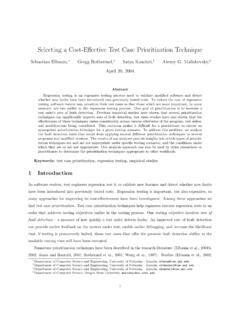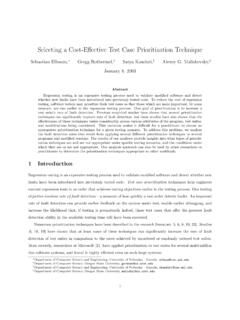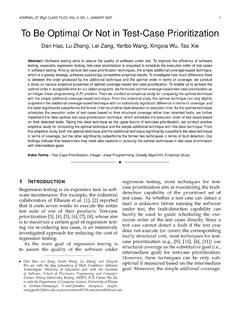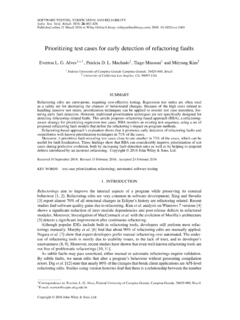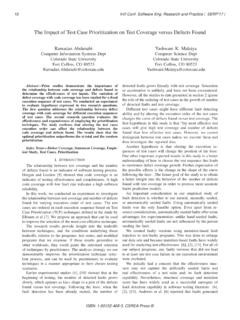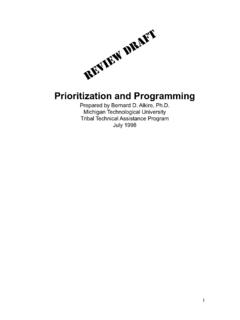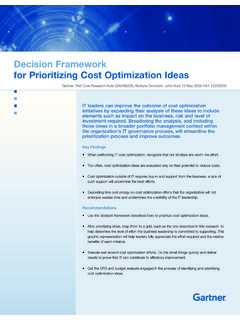Transcription of An Idiot’s Guide to Prioritization in the Health Sector
1 HNP DISCUSSION PAPERA bout this series is produced by the Health , Nutrition, and Population Family(HNP) of the World Bank s Human Development Network. The papersin this series aim to provide a vehicle for publishing preliminary andunpolished results on HNP topics to encourage discussion and findings, interpretations, and conclusions expressed in this paperare entirely those of the author(s) and should not be attributed in anymanner to the World Bank, to its affiliated organizations or to membersof its Board of Executive Directors or the countries they and the use of material presented in this series should takeinto account this provisional character. For free copies of papers inthis series please contact the individual authors whose name appearson the about the series and submissions should be made directly tothe Editor in Chief Alexander S. Preker orHNP Advisory Service tel 202 473-2256,fax 202 522-3234). For more information, see WORLD BANK1818 H Street, NWWashington, DC USA 20433 Telephone:202 477 1234 Facsimile:202 477 6391 Internet: : Idiot s Guide to Prioritization in the Health SectorAbdo S.
2 YazbeckMarch 2002 An Idiot s Guide to Prioritization in the Health Sector Abdo S. Yazbeck March 2002 The Idiot in the title refers to the author and not the reader iiHealth, Nutrition and Population (HNP) Discussion Paper This series is produced by the Health , Nutrition, and Population Family (HNP) of the World Bank's Human Development Network (HNP Discussion Paper). The papers in this series aim to provide a vehicle for publishing preliminary and unpolished results on HNP topics to encourage discussion and debate. The findings, interpretations, and conclusions expressed in this paper are entirely those of the author(s) and should not be attributed in any manner to the World Bank, to its affiliated organizations or to members of its Board of Executive Directors or the countries they represent. Citation and the use of material presented in this series should take into account this provisional character.
3 For free copies of papers in this series please contact the individual authors whose name appears on the paper. Enquiries about the series and submissions should be made directly to the Editor in Chief. Submissions should have been previously reviewed and cleared by the sponsoring department which will bear the cost of publication. No additional reviews will be undertaken after submission. The sponsoring department and authors bear full responsibility for the quality of the technical contents and presentation of material in the series. Since the material will be published as presented, authors should submit an electronic copy in a predefined format as well as three camera-ready hard copies (copied front to back exactly as the author would like the final publication to appear). Rough drafts that do not meet minimum presentational standards may be returned to authors for more work before being accepted.
4 The Editor in Chief of the series is Alexander S. Preker For information regarding this and other World Bank publications, please contact the HNP Advisory Services at: Tel (202) 473-2256; and Fax (202) 522-3234. ISBN 1-932126-16-3 2002 The International Bank for Reconstruction and Development / The World Bank 1818 H Street, NW Washington, DC 20433 iiiAll rights reserved. ivHealth, Nutrition and Population (HNP) Discussion Paper An Idiot s Guide to Prioritization in the Health Sector Abdo S. Yazbecka a South Asia Region Human Development Unit, The World Bank, Washington, Paper prepared for World Bank Institute Core Course: Adapting to Change World Bank Institute, Washington, Abstract: Every year, Ministries of Health the world over develop annual budgets for the Health Sector . Every year, donors, academicians, advocacy groups, medical trade unions and professional organizations, and Health service managers and providers complain that the budgets have the wrong priorities.
5 While all these groups are united in their unhappiness with the priorities reflected in these budgets, they disagree on what the priorities should be and on how the Prioritization process should be conducted. A review of the published literature reveals a lack of consensus in the policy and academic communities on how best to prioritize Health Sector budgets. What is more surprising is that the literature review reveals little documentation on how countries actually do prioritize Health expenditures. This paper attempts to address both gaps in information about Prioritization . The first part of the paper describes what goes into a Prioritization exercise. This typically includes advocates, Prioritization criteria, and methodologies for making choices. The first part also describes the analytical tools available to understand who gains and who loses from decisions taken in developing a budget for the Health Sector .
6 The second part of the paper (Annex 1) documents an actual Prioritization exercise undertaken in Bangladesh between the years 1996 and 1999. As the title of this paper indicates, this is not a theoretical or academic paper. It is simply meant to empower potential practitioners by introducing them to the players involved in the process, the techniques utilized by these players, the political realities that drive the process, and some evaluation techniques. Keywords: Prioritization , Health Sector Disclaimer : The findings, interpretations and conclusions expressed in this paper are entirely those of the authors and do not necessarily represent the views of the World Bank, its Executive Directors, or the countries they represent. Correspondence Details: Abdo S. Yazbeck; 1818 H. Str. NW, Washington, DC 20433, ; Tel: 202-473-0847 ; Fax: 202-522-2955; Email: v viTable of Contents I.
7 THERE IS NEVER II. ME, ME, ME, III. Prioritization IV. Prioritization V. WHO LOSES?..7 VI. BANGLADESH CASE STUDY: BUYING A $12 PACKAGE AT $ ANNEX LOG ENTRY NUMBER 1:..11 LOG ENTRY NUMBER 2:..12 LOG ENTRY NUMBER 3:..12 LOG ENTRY NUMBER 4:..13 LOG ENTRY NUMBER 5:..14 LOG ENTRY NUMBER 6:..15 LOG ENTRY NUMBER 7:..16 LOG ENTRY NUMBER 8:..17 LOG ENTRY NUMBER 9:..17 ANNEX vii viiiACKNOWLEDGEMENTS This paper originated in a background document for a session on Prioritization I taught in the World Bank Institute s Core Course on Population and Reproductive Health : Adapting to Change. I thank the participants in the course for encouraging me to complete the paper. I am sure I have forgotten a few names, but here is an alphabetized list of friends and colleagues that read earlier drafts and provided comments (some comments were actually useful!): Arlette Campbell White, Hugo Diaz-Etchevehere, Phoebe Folger, Davidson Gwatkin, Salim Habayeb, Steven Koskinen, Benjamin Loevinsohn, Hnin Hnin Pyne, David Peters, Alexander Preker, Tazim Mawji, Anthony Measham, Tom Merrick, Marc Michel, Philip Musgrove, and Rashmi Sharma.
8 Since I have no coauthors to blame, all remaining errors/omissions/misstatement are mine. ix 1I. THERE IS NEVER ENOUGH The Shiroishi family had a good year financially. With the Japanese economy picking up, both parents are earning more money than they had over the last few years and their investments in stocks have stabilized after the East Asian crisis. They sit in the living room of their Tokyo apartment to discuss the prospects for the coming year. The mother, and financial planner in the family, calculates their combined income and from that deducts their obligations like rent, car payments, schools, utilities, and other living expenses. What she is left with, and what economists call disposable income, is a bundle of cash that the family can save or spend as they wish. Since this is the first time in many years that the family has not been concerned about spending habits, the demands on the disposable income totaled three times more than what was available.
9 The father, fast approaching 45 years of age, has had his eye on the latest model Mazda Miata. He has had to drive the family s second car for eight years now and it has become a money pit constantly needing repair. His status among his colleagues at work, and therefore his future income stream, is somehow linked to the type of car he drives. The mother has a different plan in mind for the disposable income. With an eye on the rising costs of education in Japan and two young kids eventually needing financial help to go to college, she is concerned that the family equity stake has suffered from the Asia financial crises and needs re-investment. She has identified two high-performing stock funds and feels that by investing the disposable income now, the financial security of the family will be reestablished. The kids have something completely different in mind. You see there is a new entertainment complex called Joy-o-polis that all the cool kids are going to every day.
10 Their life would be sooo much better if they could get season passes . The passes are a great deal too because with one you do not have to pay for any of the rides and all the food is heavily subsidized so they can save lots of money. Clearly the Shiroishi family has a Prioritization problem. They cannot afford all three packages and there will have to be compromises, winners and losers. The final decision will depend on a number of factors, including: 1. The value the family puts on long-term returns versus short-term satisfaction; 2. Coalition building skills of the different family members; and 3. The different color options available for the Mazda Miata. A Prioritization exercise in developing government budgets for the Health Sector in any country shares some important elements with the experience of the Shiroishi family budget exercise. Both activities are driven by the same problem, which also happens to be the main drive behind microeconomic theory.












